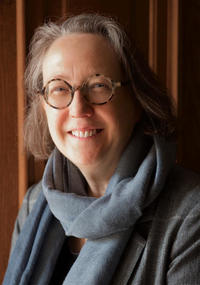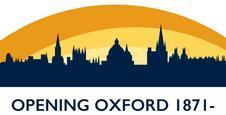Co-educational from the start, and even welcoming to Anglicans: (Harris) Manchester College in Oxford
The 1871 legislation, opening up Oxford and Cambridge to students of all beliefs (or none), inspired the tutors and trustees of Manchester New College, which was then attached to the University of London, to begin a discussion about whether to move to Oxford. That discussion went on for nearly two decades, but eventually the pro-Oxford group won, and the move was made in 1889; the College dropped the ‘new’ in its name and became known as Manchester College. The first buildings were opened in 1893, on the site the College still occupies on Mansfield Road, and the opening ceremony was reported in The Manchester Guardian. The chapel, with its Edward Burne-Jones stained glass windows and organ pipes decorated by the William Morris Company, was for all those who could not accept the dogma of any denomination. It remains so today and is currently one of the few Oxford college chapels where same-sex couples may be married.
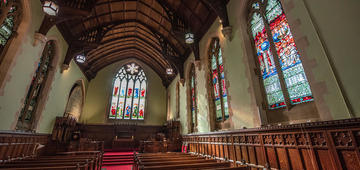
Harris Manchester College, chapel. The glory of which is the stained glass windows by Edward Burne-Jones and William Morris. The chapel is the only room in Oxford to be lit entirely by Morris/ Burne-Jones glass.
Freedom of religion was core to the College’s founding principle: namely, freely imparting theological knowledge without insisting on the adoption of particular theological doctrines. The College began as a dissenting academy in Warrington in 1757 with no theological tests of any kind. Most striking, the divinity students were free to agree or disagree with their tutors on religious matters according to their own conscience and wherever their studies – the pursuit of truth – led them. The College appealed especially to Unitarians (Christians who were nontrinitarian); it trained Unitarian ministers, and it was generously supported by donations and subscriptions from Unitarian individuals and churches, but it was never solely a Unitarian college. Before landing in Oxford in 1889, it moved around: from Warrington to Manchester to York and back to Manchester before going to London in 1853.
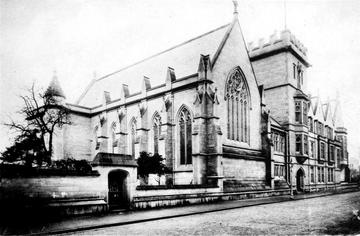
Manchester College was initially housed on the High Street but moved to its current Mansfield Road site (pictured) in 1893.
In the eighteenth and nineteenth centuries, Manchester New College did not only teach divinity, but also classics, mathematics, languages, science, literature and civil engineering. In its ranks of tutors, it included the natural philosopher and chemist, Joseph Priestley, and the philosopher James Martineau. Throughout the nineteenth century, the College continued to practise not only freedom of religious belief but also the pursuit of truth and liberty – in line with its motto: ‘To truth, to liberty, to religion.’ One tutor, William Gaskell, was a pioneer of education for the working classes (and husband of the novelist). A classics tutor, John James Tayler, was an abolitionist, giving a speech in 1850, ‘On the Question of American Slavery’. Unitarians, including students and trustees of the College, were involved in the founding and editing of The Manchester Guardian, motivated by a wish for truthful reporting of events (see https://www.hmc.ox.ac.uk/the-200th-anniversary-of-the-guardian-hub#/). The highly rational Francis William Newman (younger brother of the more conservative John Henry), who had renounced his fellowship at Balliol College when his views on infant baptism were no longer in line with those of the Church of England, was tutor in moral philosophy and a crusading vegetarian.
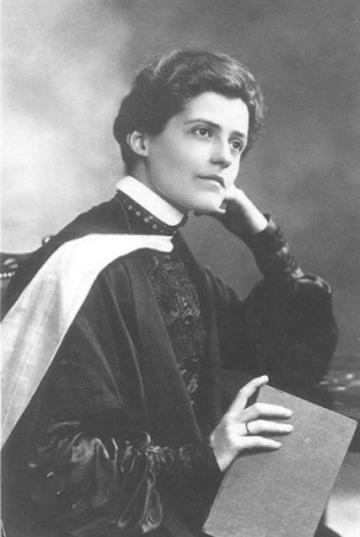
Gertrud von Petzold, the first female student (1901) after the college moved to Oxford -- the college was already co-ed when it arrived in Oxford, and remained so.
When the College came to Oxford it continued this radical trajectory. It was already co-educational, which marked it out in the Oxford environment, the College trustees having voted to admit women in 1876. The first woman to train for the Unitarian ministry at Manchester College, Oxford, was Gertrud Von Petzold who arrived in 1901. Others followed, including Margaret Brackenbury Crook in 1914, a suffragist and activist, who went on to become the Minister at the Octagon Chapel in Norwich and then Professor of Religion and Biblical Studies at Smith College in Massachusetts.
The College body was also ethnically diverse and strikingly international, with students from India - many from the Brahmo Samaj, a monotheistic Indian religious group to which Rabindranath Tagore belonged, and with which the College had connections - Japan and Transylvania. One of the first Black students to come to Oxford, James Arthur Harley, was a student at the College from 1907 to 1909 (he enrolled, too, as a student at Jesus College for reasons unknown), studying first theology and then anthropology. Born in Antigua, Harley had previously studied in the USA at Howard, where he was an undergraduate, and had then undertaken graduate work at Yale, Harvard, and Episcopal Theological seminary. He was ordained into the Church of England in 1911.
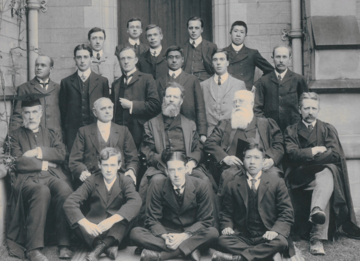
The class of 1907-8, which includes the first black student, James Arthur Harley, third row, first left.
Manchester College was not yet part of the University. Students did not therefore take Oxford degrees though most, like James Harley, coming to train for ministry, arrived with degrees from other universities. Margaret Crook, for example, had a first class degree in history from the University of London (having studied at St Anne’s Society but, as a woman, unable to receive a degree from Oxford) and a diploma with distinction in anthropology from Oxford. The informal relationship with the University was positive, with some of the College’s tutors participating in the Faculty of Theology; distinguished academics such as Max Müller and Gilbert Murray serving as the College Visitor; and the College’s many lecture series open to all across the University – the College making a particular impact in this way.
Manchester College contributed significantly and distinctively to Oxford’s intellectual and spiritual life after its opening. This was largely due to two Principals in the early twentieth century: J. Estlin Carpenter (Principal, 1906 – 1915), a pioneer in the field of comparative religion, and L. P. Jacks (Principal, 1915 - 1931), philosopher, and editor of The Hibbert Review for over 40 years. They not only brought their own scholarly distinction and public profiles, but an extraordinary array of speakers to the College, and thus to Oxford. The Harvard philosophers William James and Josiah Royce gave the Hibbert Lectures. Rabindranath Tagore visited twice: in 1913, the year he won the Nobel Prize for Literature, and in 1930 when he lectured in the College’s main hall and preached in the chapel – people crowding at the doors to hear him. The leader of the Baha’i movement, ‘Abdu’l-Bahá, visited in 1912 and spoke in the library, where his portrait remains. His visit was facilitated by a friend of the College from the University, T.K. Cheyne, who held the Oriel and Laing Chair in the Interpretation of Holy Scripture, and – in the spirit of the times - was not only an Anglican priest but also a Baha’i, and Quaker in his sympathies. The educationalist and founder of the Waldorf schools, Rudolf Steiner, lectured in 1922. In line with the College’s commitment to freedom of religion, prominent Anglicans were also invited to speak (and there was even an Anglican tutor at the College, Canon David Simpson): W. R. Inge, Dean of St Paul’s Cathedral, attracted crowds of 300 – 400 to his lectures in 1920. The following academic year, 1921 – 22, Evelyn Underhill was invited to give the Upton Lectures – the first woman to lecture in theology at Oxford. The College will be celebrating that anniversary this academic year.
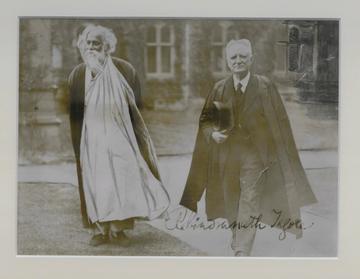
Tagore and L.P. Jacks (who was Principal of the college at the time of Tagore's second visit in 1930).
The College is also currently celebrating other significant anniversaries. 2023 will mark 125 years since the opening of its first buildings. 2021 was the 25th anniversary of the granting of its charter as a College of the University of Oxford, now named Harris Manchester College and a college for mature students over the age of 21. In doing that, it has retained and yet also renewed its mission of opening higher education to those barred from it, in this case those barred by lost or missed opportunities, as well as prejudices about age. As higher education changes to accommodate our increasing longevity, and the need for so many to retrain and reskill as technology transforms the employment landscape, Harris Manchester College hopes to remain at the forefront of educational innovation and inclusion, in the spirit of its founders and forebears.
Jane Shaw, Principal of Harris Manchester College, Professor of the History of Religion & Pro-Vice-Chancellor of the University of Oxford.
